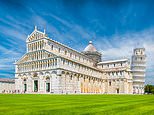
Long before Vermeer painted his Girl With A Pearl Earring (portrayed by Scarlett Johansson in the Hollywood film of the same name) there was another woman famous for her shiny pearl earrings.
She was Artemisia Gentileschi, one of the world’s most celebrated female painters. When, at the height of her fame in the 1620s, she sat for her own portrait, she wore pearl drops that would become her signature bling.
Her talent will be evident when Artemisia, the first ever show of her work, opens at the National Gallery in London next Saturday with more than 30 of her paintings, many on view for the first time in Britain.
The Daily Mail’s Deidre Fernand travelled to Tuscany to trace the roots of Artemisia Gentileschi. Pictured is Pisa Cathedral and the Tower
Feminist icon: Artemisia in her 1623 portrait
In a world dominated by the male genius of Michelangelo, Da Vinci and Raphael, Artemisia was a rarity. Born in Rome in 1593, she trained in the studio of her artist father, Orazio, before launching out on her own.
Rediscovered in recent years, she has become the poster girl of women painters. Brilliant and bold, her depictions of biblical heroines such as Judith and Susanna hang in all the world’s great collections.
She was never in doubt about her abilities, boasting in a letter of having ‘the spirit of Caesar in the soul of a woman’.
As the curator of the show, Letizia Treves, reminds us, Artemisia had to be ‘fearless and feisty’ to survive in a man’s world. She needed to be doubly fearless when, having been raped by an associate of her father’s, she endured a trial during which she was tortured with thumbscrews to test her veracity. The judge believed her. No wonder she has become a modern feminist icon.
And no one was more skilled at self-promotion than Artemisia as she touted her talents around Rome, Naples and Florence.
So pinning her down to one city is tricky. I sought to do this in Tuscany, arriving shortly before lockdown.
After all, it was in Florence that she made her name. My trail began in Buonarroti House, once the home of one of her patrons, Michelangelo the Younger, and now a museum.
The great-nephew of the sculptor, he commissioned her to decorate part of his palazzo. Portraying herself as a heavenly muse, she adorns the ceiling of the grand salon.
She appears nude, save for wisps of gauze to protect her modesty. A perfect example of 17th-century product placement.
There is no such feminine delicacy in Judith And Holofernes, on view in the city’s Uffizi gallery.
In this startling painting, the heroine wields a sword to hack off the tyrant’s head, an Old Testament example of girl power. Blood seems to seep from the canvas.
Artemisia is known for her depictions of biblical heroines. Pictured is Susanna and the Elders, 1610
‘Stupendo’, said an Italian woman beside me, lost in admiration.
So few of Artemisia’s paintings have survived that there is no danger of succumbing to get-me-outta-here museum madness. So once you have seen the handful of her works, plus a few Giottos and Botticellis, you can reward yourself with coffee and cake in the Uffizi’s cafe, the Bartolini.
Its terrace, in the shadow of Brunelleschi’s cathedral dome, offers one of the greatest views in the city. When Artemisia was working here, the cupola was already 200 years old, a true marvel.
She would also become a marvel acclaimed throughout Europe, feted by the Medicis and a friend of the astronomer Galileo, before dying of the plague in Naples around 1654.
My Artemisia adventure took me next to Pisa, from where her family could trace its roots. It is hard to understand why this small city on the Arno, just an hour from Florence by train, is so neglected.
Day-trippers who bus in to Instagram themselves against the Leaning Tower, then bus out again, don’t know what they are missing.
After all, this is where the British love affair with Italy began, with travellers disembarking at the nearby port of Livorno to begin the Grand Tour. My hotel, the Royal Victoria, had hosted the Duke of Wellington, Charles Dickens and a slew of royalty besides.
Pisa’s wonky tower is only part of a medieval campus. Buy a combined ticket for €9 and you can visit the Romanesque cathedral next door and the Campo Santo cemetery. Then cross the square to the cathedral museum and climb to the café for another superb view. And as darkness falls, the city, home to more than 60,000 undergraduates, comes alive. Students have been carousing here since 1330 and in the bars around Piazza delle Vettovaglie, I stopped to sample some Tuscan reds and almost forgot the real reason I had come.
Next morning she was waiting for us across the river in a small gallery, Palazzo Blu.
She did not disappoint. Gazing out of her portrait painted by Simon Vouet in 1623, Artemisia holds her paintbrush aloft.
The spirit of Caesar in the soul of a woman, her confident beauty and the lustre of her pearl earrings staring out from the canvas. It was magnificent. Stupendo.
TRAVEL FACTS
BA London to Pisa from £54 return (ba.com). Doubles at the Hotel Botticelli from £90 per night (hotelbotticelli.it) and the Royal Victoria Hotel Pisa from £56 (royalvictoria.it). Artemisia opens at the National Gallery next Saturday, October 3, and runs until January 24, 2021, (nationalgallery.org.uk).
Source link
CHECK OUT: Top Travel Destinations
READ MORE: Travel News



